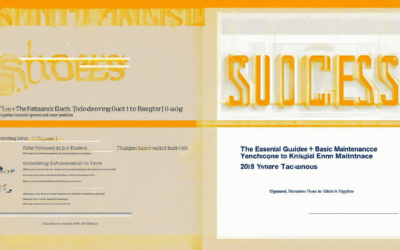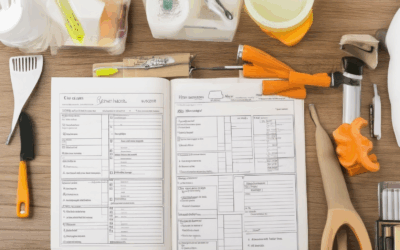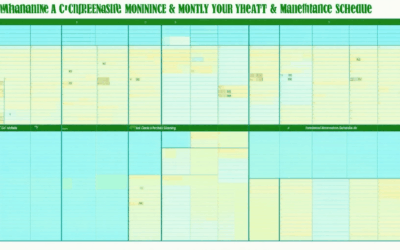Managing the upkeep and maintenance of a building or property can feel overwhelming, especially when faced with limited time and resources. However, adopting a structured approach to routine maintenance projects can not only extend the lifespan of your property but also ensure a safer and more comfortable environment for occupants. Whether you’re overseeing a large commercial space, a residential building, or even a smaller property, understanding the basics of routine maintenance is key to preventing minor issues from escalating into major, costly repairs. This comprehensive guide will walk you through the essential concepts, best practices, and practical strategies needed to create and implement an effective routine maintenance plan. By addressing common maintenance needs, exploring real-world examples, and providing actionable insights, this article aims to empower you with the knowledge and tools required to keep your property in peak condition year after year. Let’s dive into the world of routine maintenance projects and discover how they can transform the way you approach building care.

What is an example of a routine maintenance?
Routine maintenance refers to consistent checks and tasks performed to ensure the longevity and efficiency of equipment, systems, or properties. Here are some common examples:
- Lubrication: Regularly applying lubricants to moving parts to reduce friction and prevent wear.
- Cleaning: Removing dirt, debris, or obstructions from machinery or surfaces to ensure proper functioning.
- Adjustments: Fine-tuning components to optimize performance, such as tuning a car engine or balancing a fan blade.
- Inspection: Thoroughly examining equipment for signs of damage, wear, or potential issues before they escalate.
- Replacement: Replacing worn-out parts with high-quality alternatives to maintain functionality and safety.
- Testing: Evaluating systems or equipment to ensure they meet safety standards and operational requirements.
These tasks are essential for maintaining the reliability and performance of various systems, from household appliances to industrial machinery. Proper routine maintenance not only extends the lifespan of your assets but also ensures peak productivity and safety.
For more detailed guidance on home and property maintenance, visit our Sams Maintenance resource hub. Explore DIY repair guides, seasonal upkeep tips, and expert advice tailored for homeowners.
Example of a Maintenance Project
A maintenance project is a planned activity focused on preserving, extending, or restoring the useful life of an asset, such as a building, piece of equipment, or property. Here’s an example:
- Residential Home Maintenance Project
- Painting Exterior Walls – Refreshing the exterior paint job to prevent peeling and maintain curb appeal.
- Gutter Cleaning and Repair – Removing debris and fixing leaks to prevent water damage.
- Landscaping and Yard Maintenance – Trimming trees, mowing grass, and installing new plants to keep the property looking neat and healthy.
- HVAC System Service – Inspecting and servicing the heating and cooling system to ensure optimal performance and energy efficiency.
- Appliance Maintenance – Cleaning and lubricating appliances like refrigerators, dishwashers, and ovens to extend their lifespan.
- Commercial Building Maintenance Project
- Roof Repairs and Maintenance – Fixing leaks and replacing damaged shingles to protect the building and its occupants.
- Plumbing System Renovation – Upgrading outdated pipes and fixtures to improve water efficiency and functionality.
- Electrical System Rewiring – Updating electrical systems to meet modern safety standards and reduce energy consumption.
- Fire Safety Systems Installation – Installing fire alarms, sprinklers, and smoke detectors to enhance property security.
- Industrial Machinery Maintenance Project
- Lubrication and Oil Changes – Ensuring smooth operation of heavy machinery through regular lubrication and oil replacement.
- Belting and Hose Replacement – Replacing worn belts and hoses to prevent mechanical failures and downtime.
- Pump Maintenance – Servicing pumps to maintain pressure and ensure consistent performance in production processes.

What is a Routine Maintenance Plan?
A routine maintenance plan is a structured approach to preserving the integrity, functionality, and longevity of your property. Whether it’s a home, commercial building, or industrial facility, regular maintenance ensures everything runs smoothly and safely. Here’s a breakdown of what a routine maintenance plan entails:
Key Components of a Routine Maintenance Plan
- General Principles: Regular checks and tasks are performed to prevent issues before they escalate. This includes inspections, replacements, and adjustments.
- Property-Specific Examples: Maintenance plans vary by property type. For example, a residential plan might focus on HVAC systems and plumbing, while a commercial plan could involve roofing and electrical systems.
- Tools and Resources: Utilize tools like calendars, checklists, and professional guides to stay organized and informed.
- Frequency Guidelines: Schedule tasks based on usage, manufacturer recommendations, and local regulations. For instance, HVAC systems may require biannual checks, while gutters should be cleaned quarterly.
- Budget Considerations: Allocate funds for unexpected repairs and planned upgrades. A well-maintained property often costs less in the long run.
Why Routine Maintenance Matters
Maintenance isn’t just about fixing things when they break—it’s about preventing breakdowns and extending the life of your property. Regular checks can catch small issues before they become big problems, saving money and ensuring safety.
Common Maintenance Tasks
- Cleaning and Inspections: Regularly clean systems like air ducts, vents, and chimneys. Inspect for leaks, wear, and damage.
- Replacement of Parts: Replace worn-out parts like filters, belts, and bearings as recommended by manufacturers.
- Energy Efficiency Checks: Ensure systems like HVAC are operating efficiently and adjust settings for optimal performance.
- Landscaping and Exterior Care: Maintain gardens, fences, and walkways to prevent deterioration and ensure safety.
Best Practices for Effective Maintenance
- Stay Organized: Use checklists and schedules to track tasks and deadlines.
- Act Quickly: Address issues immediately to avoid further damage or costly repairs.
- Consult Professionals: For complex tasks, rely on trained experts to ensure accuracy and safety.
- Document Everything: Keep records of maintenance activities and inspections for future reference.
Resources for Further Learning
For detailed guidance, visit our maintenance resources or explore trusted sources like HomeGuide Pro and Fix My House 101 for expert insights and actionable tips.

What Are the 4 Types of Maintenance?
To maintain optimal performance and longevity of systems, equipment, and structures, four primary types of maintenance are commonly employed. Each type serves distinct purposes and is tailored to specific needs:
1. Preventive Maintenance
- Definition : Regular, scheduled maintenance performed at predetermined intervals to prevent failures before they occur.
- Benefits : Reduces downtime, extends equipment lifespan, and ensures peak efficiency.
- Examples : Changing oil filters, replacing worn parts, and conducting routine inspections.
Learn more about preventive maintenance techniques .
2. Predictive Maintenance
- Definition : Uses data analytics and monitoring tools to predict potential issues based on operational conditions.
- Benefits : Allows for proactive planning, minimizing unexpected breakdowns.
- Examples : Implementing sensors for temperature, vibration, or pressure changes.
Predictive maintenance best practices .
3. Corrective Maintenance
- Definition : Conducted in response to a specific failure or issue identified during operation or through diagnostic processes.
- Benefits : Fixes immediate problems and restores functionality.
- Examples : Repairing a leaky pipe or replacing a faulty component.
Discover corrective maintenance solutions .
4. Condition-Based Maintenance
- Definition : Triggered when certain conditions indicate maintenance is required, such as unusual wear, excessive noise, or performance degradation.
- Benefits : Customized approach based on actual equipment status.
- Examples : Adjusting belts or lubricating moving parts when signs of wear are observed.
Explore condition-based maintenance strategies .
By incorporating these maintenance types into your routine, you can ensure reliability, productivity, and cost-effectiveness across various systems and equipment.
What is Routine Building Maintenance?
Routine building maintenance refers to the consistent and regular tasks performed to ensure the smooth operation and longevity of a building or facility. This type of maintenance focuses on preventing issues before they arise, ensuring safety, and optimizing the functionality of the space.
Key Components of Routine Building Maintenance
- Inspections: Regular checks of structural components, electrical systems, plumbing, HVAC (heating, ventilation, and air conditioning) units, and exterior surfaces to identify potential issues early.
- Repairs: Addressing minor issues like leaky pipes, worn-out roofing materials, or faulty wiring to prevent more significant damage or safety hazards.
- Improvements: Making upgrades or modifications to enhance energy efficiency, improve accessibility, or modernize the building to meet current standards.
Benefits of Routine Building Maintenance
- Prevent Emergencies: Catching issues before they escalate reduces the risk of costly repairs and downtime.
- Extend Equipment Life: Regular servicing and replacement of parts can significantly extend the lifespan of systems like HVAC units and plumbing fixtures.
- Ensure Safety: Timely maintenance helps prevent accidents and ensures compliance with local building codes and safety regulations.
- Boost Property Value: A well-maintained property often attracts better tenants or buyers and commands higher prices.
Scheduling routine maintenance is essential for keeping your building in top shape. Create a checklist or use a maintenance calendar to track tasks like gutter cleaning, HVAC filter changes, and pipe inspections. By staying proactive, you can save time, money, and effort in the long run.
For more detailed guidance on specific aspects of building maintenance, explore our home maintenance guide and discover practical tips to keep your property in excellent condition year-round.

What is the Difference Between Preventive and Routine Maintenance?
Routine maintenance refers to the regular, scheduled upkeep of systems, equipment, or properties to ensure they function optimally and prevent minor issues from escalating. It is a broad term that includes tasks like checking fluid levels, cleaning, and performing routine inspections.
Preventive maintenance, on the other hand, is a more proactive approach aimed at preventing equipment failure or damage before it occurs. It involves replacing worn parts, conducting regular inspections, and addressing potential issues early to avoid costly repairs later.
| Type | Description |
|---|---|
| Routine Maintenance | Scheduled tasks meant to keep systems operating efficiently. Examples include oil changes, filter replacements, and cleaning tasks. |
| Preventive Maintenance | Proactive measures taken to prevent equipment failure. This may involve replacing components before they wear out and conducting regular inspections. |
Both types of maintenance are essential for extending the lifespan of equipment and systems. However, routine maintenance focuses on ongoing operations, while preventive maintenance targets problem prevention.
Likewise, proper preventive maintenance can significantly reduce downtime and repair costs, making it a wise investment for any property owner or operator.




0 Comments